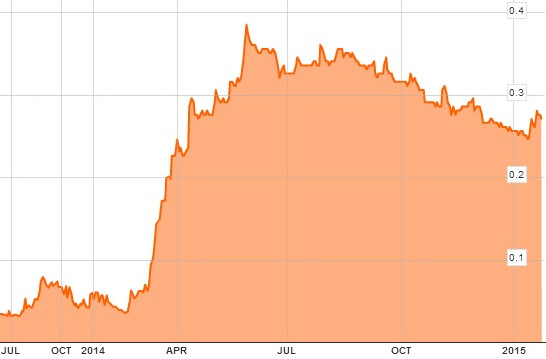|
SINCE MY my writeup on GSS Energy (formerly known as Giken Sakata) on 1 Oct 2014, its share price has weakened from $0.315 to a low of $0.245 in mid January before closing at $0.270 on 27 January 2015. After a corporate restructuring by way of a scheme of arrangement, the stock resumed trading yesterday (Thurs) under the name of GSS Energy Limited. As one of GSS Energy’s main businesses is oil production, the >50% slump in oil price has led many investors to reconsider its business prospects. |
Impact on oil price slump manageable
GSS Energy sells its oil to Pertamina and the selling price is fixed for a year, subject to an annual review by Pertamina. According to management, if Pertamina wishes to change the selling price, it also has to change the USD/
In other words, Pertamina can either keep the selling price unchanged, or change both the selling price as well as the USD/
The USD/
Senergy report on three oil fields – a near term catalyst
|
Senergy is likely to release the valuation report on GSS Energy’s three fields (Kawengan, Trembul and Gabus) in 1Q 2015.
For the first two fields, namely D&W and Tunggul, Senergy valued them on the best scenario net present value of US$195m, or S$263m based on a 10% discount rate. (See table above)
Kawengan, Trembul and Gabus fields have at least 161 oil wells vs the 131 wells from the D&W and Tungkul fields.
In addition, according to management, Trembul and Gabus fields have deeper oil wells than the other fields, providing greater potential for the production of oil.
Thus, it is likely that the three fields would fetch a higher valuation (notwithstanding the drop in the oil price) than D&W and Tunggul oil fields.
Both valuation reports on GSS Energy’s five fields should shed some light on its reserves valuation and reflect the stark difference between the reserves valuation and its market capitalization of S$128m as at 27 Jan 2015.
 Sydney Yeung, CEO of Giken Sakata.
Sydney Yeung, CEO of Giken Sakata.
NextInsight file photoTakes delivery of three more rigs this year
As of end Nov 2014, GSS Energy produced about 1,070 barrels of oil per day. According to a DMG report dated Jan 2015, GSS Energy has one land rig in operation and is expected to take delivery of three land rigs in 2015. This should increase their oil production in the months ahead.
Precision engineering business performed well in 2014
Giken’s FY14 revenue from its precision engineering business dropped 46% from S$126.8m in FY13 to S$69.0m in FY14. However, net profit soared 475% from S$446K in FY13 to S$2.1m in FY14.
According to their FY14 results press release, management is positive on its contract manufacturing business which should bode well for their FY15 results.
1HFY15 and FY15 results likely to be strong
Besides the positive outlook on GSS Energy’s precision engineering business, there will be maiden contribution from its oil business in 1HFY15 (ending Feb 2015) results and beyond. Ceteris paribus, FY15F should be a better year for GSS.
Valuation
After my writeup on GSS Energy on 1 Oct 2014, DMG Securities and Religare initiated coverage with target prices of $0.650 and $0.510, respectively. When Senergy release its valuation report on the other three fields, ii would serve as an alternative independent valuation yard stick for investors.  GSS Energy (fka Giken Sakata) recently closed at 28 cents for a market cap of S$128 million. Chart: Bloomberg.
GSS Energy (fka Giken Sakata) recently closed at 28 cents for a market cap of S$128 million. Chart: Bloomberg.
Giken’s chart analysis
GSS Energy has been entrenched in a downtrend since Jun 2014. It has to breach the strong resistance around $0.290 – 0.300 with volume expansion for the chart to turn positive.
Near term supports and resistances are at $0.260 – 0.265 / 0.245 & $0.280 / 0.290 - 0.300 respectively.
Conclusion – Unique business model, less affected by swings in oil price
In a nutshell, although one of GSS Energy business segments (i.e. oil production) is the least favoured sector now, there is some merit in GSS Energy oil business model.
It is noteworthy that the >50% slump in oil price may not affect GSS Energy to a large extent. However, whether GSS Energy share price re-rates or not depends on the company’s FY15F results, Senergy’s report on its three fields and management’s communication of its unique business model to the investment community.
Readers who are interested should take a look at the company's website for more information. They can also email me at
Recent story: OSK-DMG: Why Giken Sakata, Ezion, Nam Cheong, Keppel Corp & Marco Polo Marine








